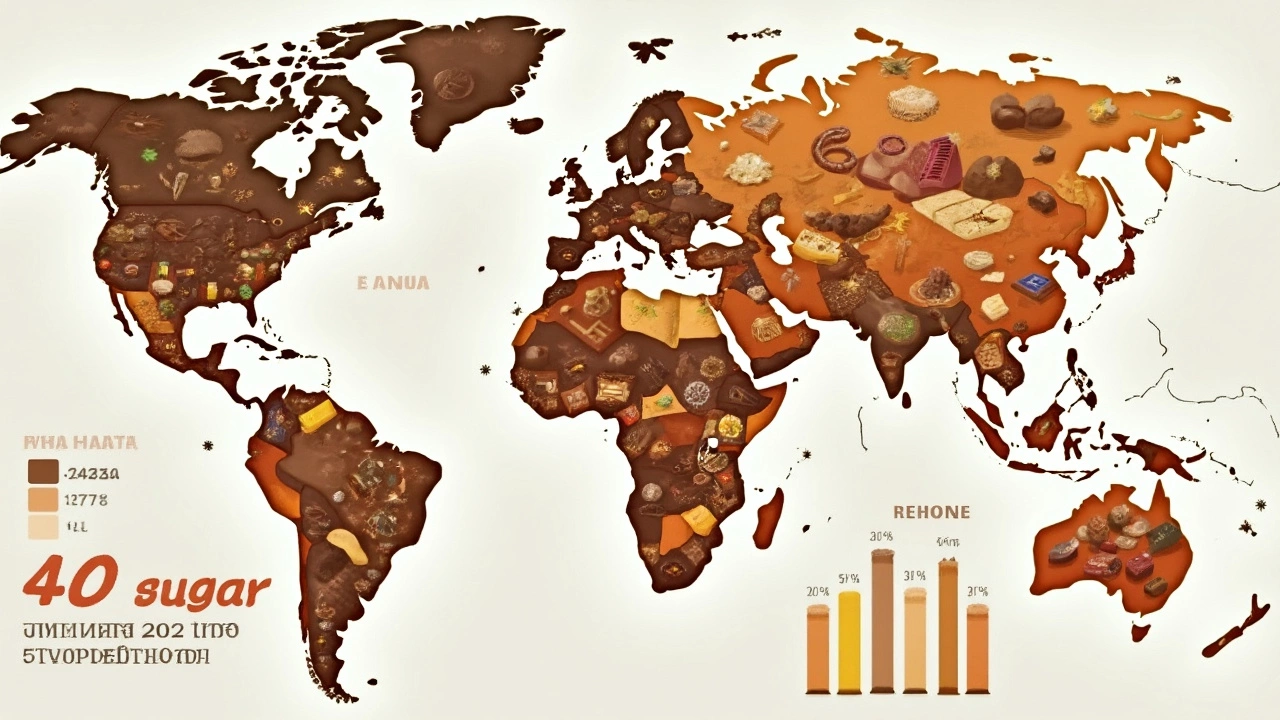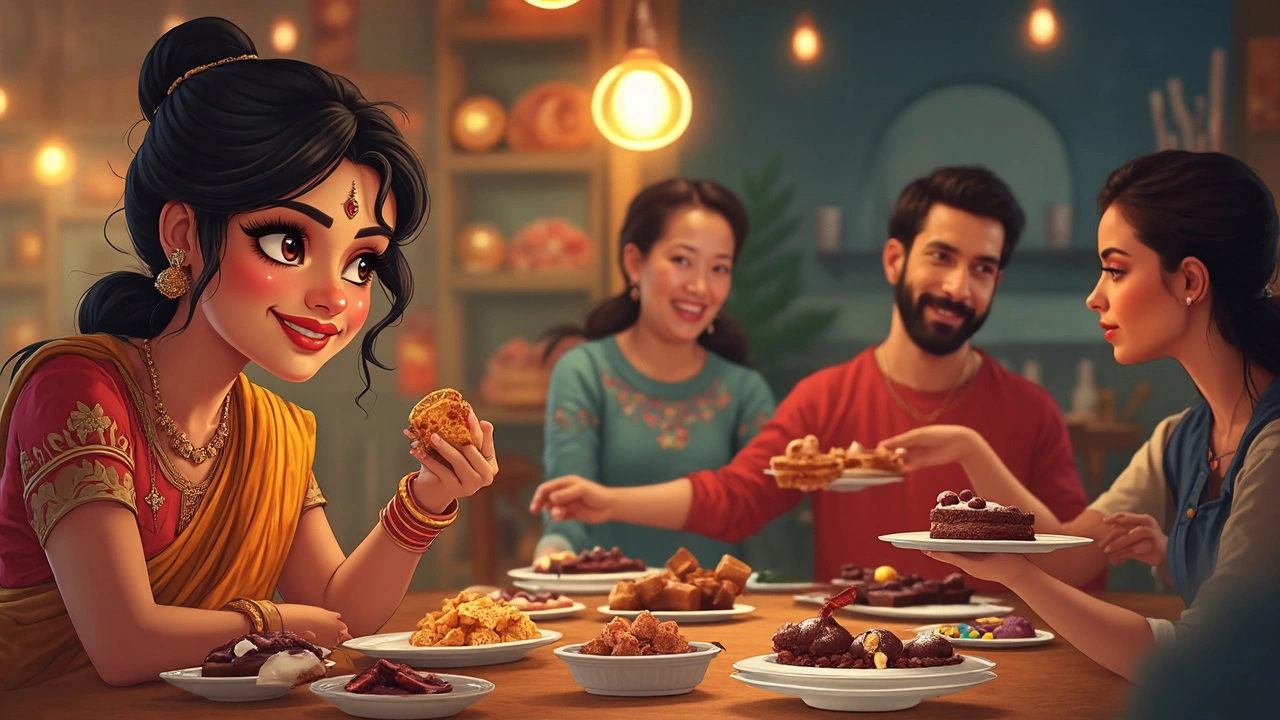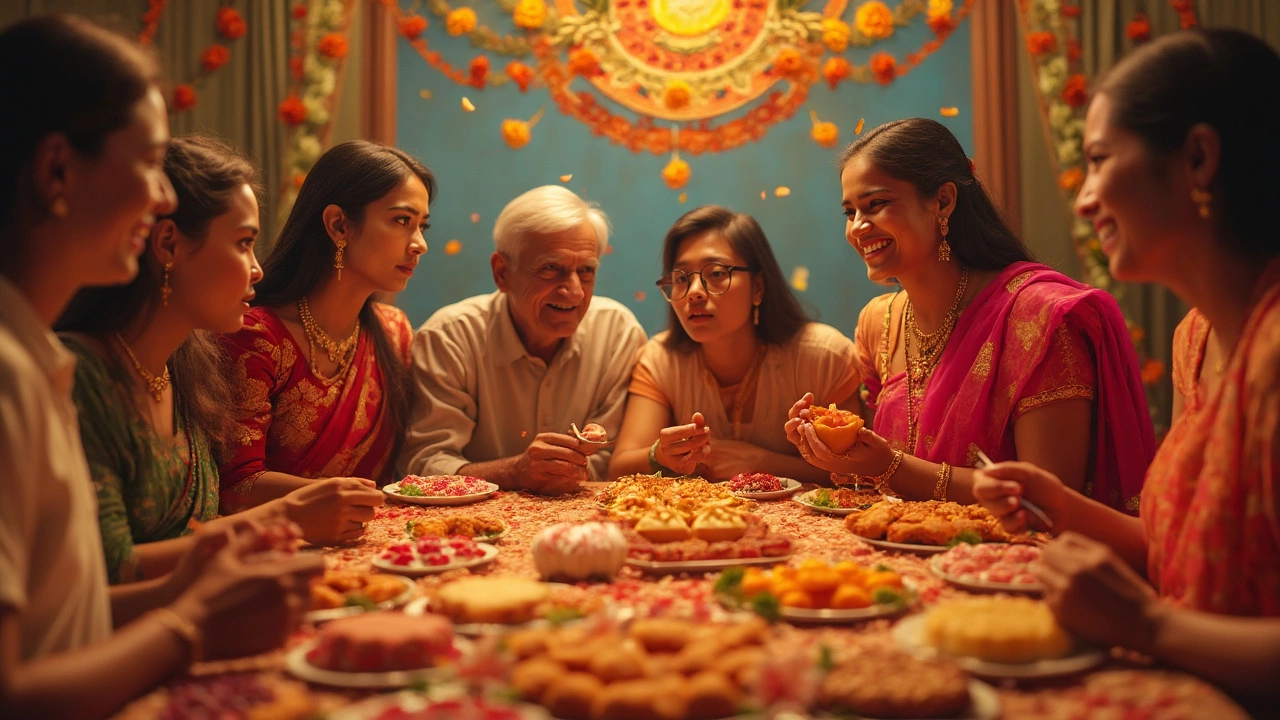6 Jun 2025
- 0 Comments
Ever wondered who actually eats the most sweets in the world? You might guess the US, with its grocery aisles stuffed with candy bars, or maybe France, thanks to those irresistible pastries. But the answer is a mix of surprises—and yes, it’s got a twist if you love Indian desserts.
People eat more sugar now than ever. Just think about the last time you went to a festival—everywhere you turn, there’s something sweet. This isn’t just about birthday cakes or ice cream. Around the world, whole cuisines are built around sugar, and Indians are right up there with mithai like gulab jamun, jalebi, and barfi at every celebration.
If you’re curious about which country munches the most, or how Indian sweets stack up, you’re in the right place. We’ll break it down: who leads the pack, why Indian mithai holds its own, and how you can still enjoy every bite without feeling weighed down by sugar.
- Stacking Up Sugar: Which Countries Lead?
- Inside India’s Dessert Craze
- Global Sweet Tooth: Surprising Stats
- What Makes Indian Sweets So Addictive?
- Smart Ways to Enjoy Sweets Without Overdoing It
Stacking Up Sugar: Which Countries Lead?
If you thought the world’s biggest sweet tooth belonged to India, you might be surprised. The top spot for sugar and sweet eats actually goes to the United States. According to the World Atlas, the average American eats about 126 grams of sugar per day—basically more than double the recommended daily amount. What’s fueling that? Think sodas, processed snacks, candy, and desserts everywhere you look.
Following close behind the US are countries like Germany, the Netherlands, and Ireland. Germans, for example, average up to 102 grams of sugar every day—no wonder they love their chocolate and pastries! A lot of European countries make it onto the list thanks to a mix of rich cakes and a love for sweet breakfast spreads.
Now, when you zoom in on nationality sweets consumption in India, you’ll find folks do love sugar, but per person, the average is lower compared to Western countries. That doesn’t mean Indian sweets aren’t a big deal—if you add up the amounts eaten during festivals, weddings, and family get-togethers, you’ll see sugar rushes happen often, but they’re usually concentrated around events.
Here’s a quick breakdown of the average daily sugar intake by country (approximate figures):
- United States – 126 grams
- Germany – 102 grams
- Netherlands – 102 grams
- Ireland – 97 grams
- Australia – 96 grams
For India, it’s around 19-20 grams per day per person, but during Diwali or Holi? All bets are off. The numbers go way up thanks to mithai shops working overtime. So, while Western countries lead the sugar scoreboard, India brings serious competition on special occasions.
Inside India’s Dessert Craze
Walk into any Indian home during a festival and you’ll usually find a table packed with colorful mithai—think laddoos, rasgullas, jalebi, and peda. It’s not just about taste; these desserts are woven into daily life, from religious offerings and weddings to winning a cricket match or even starting a new job. Sweets aren’t just a season thing; they’re a year-round habit for millions across India. If you’ve ever been handed a box of sweets at work or by a neighbor, you know what I mean.
India’s dessert culture is intense. While the country isn’t #1 globally for total sugar intake per person, a 2023 study by the Indian Council of Medical Research showed that urban Indians, especially in big cities like Delhi and Mumbai, eat much more sugar than rural folks. A lot of that comes from sweets. Some families whip up mithai at home, while others head to their local halwai (sweet shop) for treats made fresh—all day, every day.
The list of Indian sweets is seriously long. These aren’t just random sugar bombs, either. Each region has favorites: the Bengalis love their spongy rasgulla, Gujaratis can’t resist sweet and salty mohanthal, and down South, Mysore pak is a must-have. The cool part? Most traditional Indian desserts use local ingredients like ghee, milk, jaggery, nuts, and spices. That gives them their rich, distinct flavors. Some sweets have deep history too—jalebi is mentioned in ancient Sanskrit texts, while peda became popular thanks to temples in Mathura.
The connection to daily life is what makes Indian sweets special. There’s a sweet for every mood, moment, and milestone—no exaggeration. They might not take the crown for highest per-person sweets consumption, but there’s no other place where Indian sweets play such a big role in culture, festivity, and everyday joy.

Global Sweet Tooth: Surprising Stats
Let’s talk numbers because nothing’s as clear as cold, hard facts. According to the World Health Organization’s 2024 report, the United States still tops the charts when it comes to eating sweets. The average American takes in about 130 grams of sugar per day. That’s more than three times the recommended daily amount! It’s not just about cakes and candy—think of all the sweet sodas, hidden sugars in sauces, and snacks.
But wait, Europe isn’t far behind. Germans and the Swiss are right up there, with people in Germany eating almost 29 kilograms of chocolate per person a year. That’s the weight of a small dog in just chocolate! The Swiss aren’t much behind either.
Now, you’d think India would easily make the top five, considering how much mithai is everywhere at weddings, holidays, and even regular family dinners. But here’s the twist: while Indians love sweets, the per-person sugar consumption is lower, sitting around 19 kilograms per year. This is still high compared to global averages, but it lags behind the sugar habits of the US and much of Europe.
Here’s something wild—countries in South America, like Brazil and Argentina, also love their sweets, mostly through sugary drinks and snacks. Each region has its favorites, but nothing beats India when it comes to variety in desserts. There’s always something new coming out of a local sweet shop, from coconut barfi to the latest chocolate peda twist.
If you take one thing away from all these sweets statistics, it’s this: every country has its own sugar story. But the leader, at least for now, is the US, with Europe biting at its heels. India is a champion in dessert culture, though, with sweets woven into daily life and celebrations like nowhere else.
What Makes Indian Sweets So Addictive?
Indian sweets aren’t just desserts—they’re a whole experience. One key thing that makes them so tempting is the magic combo of sugar, milk, and ghee. It’s not fancy ingredients; it’s how they come together. Add in flavors like cardamom, saffron, and rosewater, and you get a treat that hits every taste bud.
There’s also a serious science behind it. Our brains love the quick rush of energy from sugar, and every bite of mithai gives you that. But Indian sweets add fat from ghee and milk, making them rich and satisfying. These ingredients don’t just taste good—they signal our brain’s pleasure centers, which is why it’s so easy to reach for a second (or third) piece.
Here are a few more things that make them irresistible:
- Texture variety: From the crunch of soan papdi to the silkiness of rasmalai, Indian desserts have it all.
- Flavors pop: Real spices (not extracts!) make a difference. Cardamom, nutmeg, cumin, and sometimes even black pepper add layers to every bite.
- Freshness: Most mithai is made fresh for festivals or parties. No preservatives—just straight-up homemade goodness.
Let’s look at how Indian sweets stack up on the world dessert stage. Notice the serious sugar content per 100 grams in some favorites:
| Sweet | Approx. Sugar per 100g (g) |
|---|---|
| Gulab Jamun | 38 |
| Jalebi | 54 |
| Rasgulla | 24 |
| Barfi | 35 |
| Soan Papdi | 40 |
See those numbers? No wonder people keep coming back for more. The sweet hit is intense compared to most Western desserts.
Another thing—mithai is tied to special moments. Sweets show up at every Indian wedding, holiday, birthday, or prayer. There’s an emotional pull, too. Eating a peda reminds you of home or a favorite relative who always had a box ready. It’s not just about the taste; it’s memories wrapped in sugar.
Curious to make yours a bit healthier? People swap sugar for jaggery or add nuts and seeds. The flavor holds up, and you might even end up with a new family favorite.

Smart Ways to Enjoy Sweets Without Overdoing It
No one wants to skip their favorite mithai at a family get-together. But it’s easy to go overboard, especially when boxes of rasgullas or jalebi are calling your name. Good news: you don’t have to ditch Indian sweets or desserts from other countries. There are simple habits that help you enjoy them without turning every treat into a **nationality sweets consumption** challenge.
- Watch the portion size. Most Indian sweets pack a lot of sugar and ghee in a small bite. Try cutting laddoos or barfi into smaller pieces if you want more than one taste without all the sugar rush.
- Set a treat time. People who save sugary stuff for certain days are less likely to binge. Sunday special jalebi or festival pedas make the moment feel more special and help keep your daily sugar intake lower.
- Homemade tweaks. Making sweets at home means you control what goes inside. Use low-fat milk, natural sweeteners like dates or jaggery, or even try baking instead of frying. Swapping out part of the sugar for cardamom, coconut, or nuts can trick your taste buds into feeling just as happy.
- Pair sweets with real food. Eating a sweet after a meal (rather than on an empty stomach) slows down sugar absorption and keeps energy levels stable. It also makes it less tempting to fill up on desserts alone.
Some countries have started labeling their snacks with clear sugar content, and some Indian brands now do this too. This helps you know exactly how much sugar is in every bite. When cravings hit, try water, herbal tea, or even a handful of fruit to cut down the urge for an extra piece.
No need to quit sweets cold turkey. With a few easy swaps and by being picky about when and what you eat, you can still enjoy those treats from any part of the world, guilt-free.
